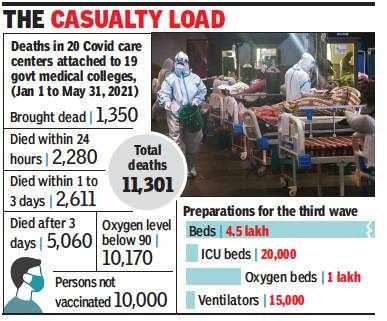The figures suggest that more than 40% of all casualties in these facilities, which are the tertiary care centres in their respective regions, may have been the outcome of patients not reaching on time– 1,350 were brought dead to these hospitals, 2,280 died within 24 hours of admission, and 2,611 persons died within 1-3 days of admission. The remaining 5,060 persons died three days after admission.
The audit by the medical education department revealed that the oxygen saturation levels of 10,170 among the deceased were below 90 (95 is the safe level).
The largest number of deceased were brought to Pune’s BJ medical college (517), followed by Government Medical College, Nagpur (368) and the Indira Gandhi Medical College, Nagpur (232). The newly opened Jalgaon Government Medical College had no cases of patients brought dead.
Speaking of the audit, director of medical education and research T P Lahane said, “We have analysed the deaths, taken note of causes and in days to come, we will enhance level of treatment in all medical colleges. We will ask the deans to study each and every death and take corrective measures accordingly.”
Lahane felt infrastructure needed to be strengthened on top priority to reduce Covid-19 deaths. “We will have to ensure availability of beds, ICU beds and address issues of fire audit and structural audit for safety and security of patients,’’ he said.
Lahane said stringent infection prevention measures, uninterrupted supply and optimum utilization of medicines, equipment as well as trained human resources to provide services to all age groups were the key requirements to tackle the situation.
He said the pressure on healthcare staff needed to be eased by utilizing services of alternative medicine doctors, such as those with BAMS, BHMS, BUMS degrees, and paramedics. Redefining the role of alternative medicine doctors and training them to use their services with immediate effect was the need of the hour to be prepared for the third wave.
In addition, an assessment of hospital preparedness at regular intervals and availability of 8-10 weeks of medicines and oxygen stock was needed to handle a surge, he said.
Lahane said on 25,000 cases were recorded on September 25 last year, while on April 14, when the second wave peaked, there were 68,000 in a single day. Now the department is prepared to tackle up to 80,000 cases in the event of a third wave. “We have adequate infrastructure, we have 20,000 ICU beds, one lakh oxygen beds, 15,000 ventilators and 4.5 lakh regular beds,’’ he said.
A former dean said that the medical education wing will also have to aim for early identification of disease, identification of patients with co-morbidities, institutionalise steady monitoring for red flag signs and for prompt treatment to prevent deaths. “We need stringent preventive measures to halt the hospital deaths. In several cases, it was found that patients did not take the initial symptoms seriously and rushed to the hospital when it was too late,’’ he said.
Stay connected with us on social media platform for instant update click here to join our Twitter, & Facebook
We are now on Telegram. Click here to join our channel (@TechiUpdate) and stay updated with the latest Technology headlines.
For all the latest Health News Click Here
For the latest news and updates, follow us on Google News.

